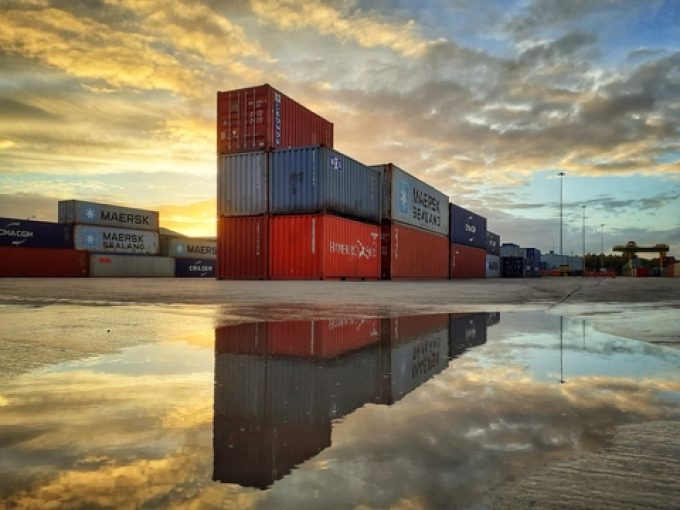'Usual' shortage of seasonal workers creating delays on Europe's waterways
Shortages of seasonal workers have prompted delays across Europe’s inland waterways, leaving many in the ...
TFII: SOLID AS USUALMAERSK: WEAKENINGF: FALLING OFF A CLIFFAAPL: 'BOTTLENECK IN MAINLAND CHINA'AAPL: CHINA TRENDSDHL: GROWTH CAPEXR: ANOTHER SOLID DELIVERYMFT: HERE COMES THE FALLDSV: LOOK AT SCHENKER PERFORMANCEUPS: A WAVE OF DOWNGRADES DSV: BARGAIN BINKNX: EARNINGS OUTODFL: RISING AND FALLING AND THEN RISING
TFII: SOLID AS USUALMAERSK: WEAKENINGF: FALLING OFF A CLIFFAAPL: 'BOTTLENECK IN MAINLAND CHINA'AAPL: CHINA TRENDSDHL: GROWTH CAPEXR: ANOTHER SOLID DELIVERYMFT: HERE COMES THE FALLDSV: LOOK AT SCHENKER PERFORMANCEUPS: A WAVE OF DOWNGRADES DSV: BARGAIN BINKNX: EARNINGS OUTODFL: RISING AND FALLING AND THEN RISING

Yard utilisation levels are below 60% at some container terminals in Northern Europe – just when they should be brimming with peak season imports.
A year ago, it was rare to see a ship-to-shore crane not boomed down at container hubs in the Le Havre – Hamburg range, with several ships anchored outside awaiting a berth.
But 12 months on, the 24,000 teu ultra-large vessels plying the Asia-North Europe tradelane can virtually secure a berth and work on arrival.
The first-half throughput figures at Rotterdam, the busiest container hub in North Europe, saw a decline of 8.1%, compared with the previous year, to 6.7m teu, impacted by the fall in imports from Asia and termination of cargo volumes to Russia.
Port of Rotterdam Authority attributed the import decline to “the current geopolitical situation and high inflation”.
It added: “Limited growth in the Dutch economy and recessions abroad are depressing global trade volumes and industrial production.”
Terminal operators have also seen a sharp decline in storage charge revenue, as landside congestion has all but disappeared.
Moreover, the bottom line for terminal operators, which is already depleted by reductions in stevedoring and storage charges, will be further knocked by huge wage settlements, a massive spike in energy costs and other high inflation-linked increases.
Although negotiations for new annual terminal contracts with carriers will reflect a degree of inflation-linked increases, terminal operators will be mindful of the available capacity at rival hubs when deciding to push hard for significant increases in stevedoring charges.
Meanwhile, Drewry’s latest Global Container Terminal Operators Annual Review and Forecast report highlights the increased importance shown by ocean carriers in investing their windfall profits, garnered in the past two years of post-pandemic demand frenzy, in container terminals through M&A activity – which includes Hapag-Lloyd, ONE, MSC and Wan Hai.
Nevertheless, Drewry’s ranking of the leading international global operators for 2022, saw PSA International retain the top spot, with a total throughput of 61m teu across its facilities worldwide, which was 3.6% lower than the year before.
China Cosco Shipping and China Merchants Ports bucked the trend of other terminal operator rivals, the former improving its volume 4.2% year on year, to 52.9m teu, and the latter increasing throughput by 5.4%, to 50.6m teu, to take second and third in the rankings.
“China Cosco Shipping gained ground on the back of its increased stake in Tianjin Container Terminal, while China Merchant’s equity-throughput gains follow on from the uplift in shareholding in Shanghai International Ports Group and Ningbo Zhoushan Port Co,” said Drewry.
APM Terminals slipped down the container terminal operator rankings to fourth, with its throughput of 46.5m teu last year, down 3.1%, and DP World also saw a 3.1% decline, to 46.5m teu, at fifth, followed by Hutchison Ports, down 3.6%, at 45.1m teu.
Comment on this article
Thomas Ogden
July 25, 2023 at 10:14 pmOf course these Chinese figures are completely reliable as they never inflate them. I mean everyone else is down but China up. Withh reshoring and near shoring going on around the world how can China have great numbers. China’s exports are down across-the-board. Stop being afraid of these people and report the truth before you lose credibility.